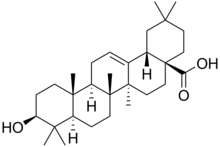Oleanolic acid or oleanic acid is a naturally occurring pentacyclic triterpenoid related to betulinic acid. It is widely distributed in food and plants where it exists as a free acid or as an aglycone of triterpenoid saponins.[2]

| |
| Names | |
|---|---|
| IUPAC name
3β-Hydroxyolean-12-en-28-oic acid
| |
| Systematic IUPAC name
(4aS,6aS,6bR,8aR,10S,12aR,12bR,14bS)-10-Hydroxy-2,2,6a,6b,9,9,12a-heptamethyl-1,3,4,5,6,6a,6b,7,8,8a,9,10,11,12,12a,12b,13,14b-octadecahydropicene-4a(2H)-carboxylic acid | |
| Other names
Oleanic acid
| |
| Identifiers | |
3D model (JSmol)
|
|
| ChEBI | |
| ChEMBL | |
| ChemSpider | |
| ECHA InfoCard | 100.007.347 |
| EC Number |
|
PubChem CID
|
|
| UNII | |
CompTox Dashboard (EPA)
|
|
| |
| |
| Properties | |
| C30H48O3 | |
| Molar mass | 456.711 g·mol−1 |
| Appearance | White |
| Melting point | > 300 °C (572 °F; 573 K) |
Except where otherwise noted, data are given for materials in their standard state (at 25 °C [77 °F], 100 kPa).
| |
Natural occurrence
editOleanolic acid can be found in olive oil, Phytolacca americana (American pokeweed), and Syzygium spp, garlic, etc. It was first studied and isolated from several plants, including Olea europaea[3] (leaves, fruit), Rosa woodsii (leaves), Prosopis glandulosa (leaves and twigs), Phoradendron juniperinum (whole plant), Syzygium claviflorum (leaves), Hyptis capitata (whole plant), Mirabilis jalapa[4] and Ternstroemia gymnanthera (aerial part). Other Syzygium species including java apple (Syzygium samarangense) and rose apples contain it, as does Ocimum tenuiflorum (holy basil).
Biosynthesis of oleanolic acids
editOleanolic acid biosynthesis starts with mevalonate to create squalene. Squalene monooxygenase in the next step oxidases the squalene and forms an epoxide resulting in 2,3-oxidosqualene.[5] Beta-amyrin synthase creates beta-amyrin by a ring formation cascade.[5][6] After the formation of beta amyrin, CYP716AATR2, also known as a cytochrome p450 enzyme, oxidizes carbon 28 turning it into alcohol.[6] CYP716AATR2 converts the alcohol to aldehyde and finally to a carboxylic acid forming oleanolic acid.[6]
Pharmacological research
editOleanolic acid is relatively non-toxic, hepatoprotective, and exhibits antitumor and antiviral properties.[7] Oleanolic acid was found to exhibit weak anti-HIV[8] and weak anti-HCV activities in vitro, but more potent synthetic analogs are being investigated as potential drugs.[9]
An extremely potent synthetic triterpenoid analog of oleanolic acid was found in 2005, that is a powerful inhibitor of cellular inflammatory processes. They work by the induction by IFN-γ of inducible nitric oxide synthase (iNOS) and of cyclooxygenase 2 in mouse macrophages. They are extremely potent inducers of the phase 2 response (e.g., elevation of NADH-quinone oxidoreductase and heme oxygenase 1), which is a major protector of cells against oxidative and electrophile stress.[10]
A 2002 study in Wistar rats found that oleanolic acid reduced sperm quality and motility, causing infertility. After withdrawing exposure, male rats regained fertility and successfully impregnated female rats.[11] Oleanolic acid is also used as standard for comparison of hyaluronidase, elastase and matrix-metalloproteinase-1 inhibition of other substances in primary research (similar to diclofenac sodium for comparison of analgesic activity).[12][13]
Oleanolic acid activates telomerase in peripheral blood mononuclear cells (PBMCs) 5.9-fold, more than any other compounded tested, with the exception of Centella asiatica (8.8-fold).[14] Less telomerase activation is seen for Astragalus extract 4.3-fold, TA-65 2.2-fold, and maslinic acid 2-fold.[14]
See also
edit- Ursolic acid
- Betulinic acid
- Moronic acid
- Momordin (saponin), a glycoside of oleanolic acid
- List of phytochemicals in food
References
edit- ^ "Oleanolic acid". Sigma-Aldrich. Merck. Retrieved November 29, 2018.
- ^ Pollier J, Goossens A (May 2012). "Oleanolic acid". Phytochemistry. 77: 10–15. doi:10.1016/j.phytochem.2011.12.022. PMID 22377690.
- ^ "Oleanolic acid (HMDB0002364)". HMDB. Canadian Institutes of Health Research. Retrieved November 29, 2018.
- ^ Siddiqui S, Siddiqui BS, Adil Q, Begum S (1990). "Constituents of Mirabilis jalapa". Fitoterapia. 61 (5): 471. Archived from the original on 2014-01-04.)
- ^ a b Fukushima EO, Seki H, Ohyama K, Ono E, Umemoto N, Mizutani M, et al. (December 2011). "CYP716A subfamily members are multifunctional oxidases in triterpenoid biosynthesis". Plant & Cell Physiology. 52 (12): 2050–2061. doi:10.1093/pcp/pcr146. PMID 22039103.
- ^ a b c Dale MP, Moses T, Johnston EJ, Rosser SJ (2020-05-01). "A systematic comparison of triterpenoid biosynthetic enzymes for the production of oleanolic acid in Saccharomyces cerevisiae". PLOS ONE. 15 (5): e0231980. Bibcode:2020PLoSO..1531980D. doi:10.1371/journal.pone.0231980. PMC 7194398. PMID 32357188.
- ^ Liu J (December 1995). "Pharmacology of oleanolic acid and ursolic acid". Journal of Ethnopharmacology. 49 (2): 57–68. doi:10.1016/0378-8741(95)90032-2. PMID 8847885.
- ^ Mengoni F, Lichtner M, Battinelli L, Marzi M, Mastroianni CM, Vullo V, Mazzanti G (February 2002). "In vitro anti-HIV activity of oleanolic acid on infected human mononuclear cells". Planta Medica. 68 (2): 111–114. doi:10.1055/s-2002-20256. PMID 11859458.
- ^ Yu F, Wang Q, Zhang Z, Peng Y, Qiu Y, Shi Y, et al. (June 2013). "Development of oleanane-type triterpenes as a new class of HCV entry inhibitors". Journal of Medicinal Chemistry. 56 (11): 4300–4319. doi:10.1021/jm301910a. PMID 23662817.
- ^ Dinkova-Kostova AT, Liby KT, Stephenson KK, Holtzclaw WD, Gao X, Suh N, et al. (March 2005). "Extremely potent triterpenoid inducers of the phase 2 response: correlations of protection against oxidant and inflammatory stress". Proceedings of the National Academy of Sciences of the United States of America. 102 (12): 4584–4589. Bibcode:2005PNAS..102.4584D. doi:10.1073/pnas.0500815102. PMC 555528. PMID 15767573.
- ^ Mdhluli MC, van der Horst G (October 2002). "The effect of oleanolic acid on sperm motion characteristics and fertility of male Wistar rats". Laboratory Animals. 36 (4): 432–437. doi:10.1258/002367702320389107. PMID 12396287. S2CID 34990111.
- ^ Maity N, Nema NK, Sarkar BK, Mukherjee PK (2012). "Standardized Clitoria ternatea leaf extract as hyaluronidase, elastase and matrix-metalloproteinase-1 inhibitor". Indian Journal of Pharmacology. 44 (5): 584–587. doi:10.4103/0253-7613.100381. PMC 3480789. PMID 23112418.
- ^ Nema NK, Maity N, Sarkar BK, Mukherjee PK (September 2013). "Matrix metalloproteinase, hyaluronidase and elastase inhibitory potential of standardized extract of Centella asiatica". Pharmaceutical Biology. 51 (9): 1182–1187. doi:10.3109/13880209.2013.782505. PMID 23763301. S2CID 24453413.
- ^ a b Tsoukalas D, Fragkiadaki P, Calina D (2019). "Discovery of potent telomerase activators: Unfolding new therapeutic and anti-aging perspectives". Molecular Medicine Reports. 20 (4): 3701–3708. doi:10.3892/mmr.2019.10614. PMC 6755196. PMID 31485647.